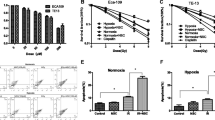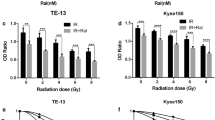Abstract
Currently, unresectable esophageal squamous cell carcinoma (ESCC) is primarily treated by chemoradiotherapy. However, the outcome has not improved significantly due to radioresistance of cancer cells. This study aimed to determine the radiosensitizing effect of LCL161, a novel second mitochondrial-derived activator of caspase (Smac) mimetic, in ESCC cells. ESCC cell lines were treated with LCL161 or radiation, alone or in combination. Cell proliferation was detected by MTT assay. Radiosensitization was evaluated by clonogenic survival assay. Cell apoptosis was detected by flow cytometry. The results showed that LCL161 potently sensitized ESCC cells to radiation with a sensitization enhancement ratio of 1.4–2.0. LCL161 increased radiation-induced DNA double-stranded breaks and promoted the apoptosis of ESCC cells, which could be abrogated by a pan-caspase inhibitor z-VAD-FMK. Furthermore, LCL161 decreased the level of cIAP1 in ESCC cells in a dose-dependent manner and synthesized with irradiation to promote the activation of caspase 8 and the upregulation of TNFα expression in ESCC cells. In conclusion, LCL161 acts as a strong radiosensitizer in human esophageal cancer cells by inhibiting the expression of cIAP1 and promoting the activation of caspase 8, leading to enhanced apoptosis.






Similar content being viewed by others
References
Jemal A, Bray F, Center MM, Ferlay J, Ward E, Forman D. Global cancer statistics. CA Cancer J Clin. 2011;61:69–90.
Zhu H, Wang Q, Hu C, Zhang W, Quan L, Liu M, et al. High expression of survivin predicts poor prognosis in esophageal squamous cell carcinoma following radiotherapy. Tumour Biol. 2011;32:1147–53.
Li J, Li ZN, Bao QL, Ge LP, Li XQ, Chen P. Evaluation of pleural fluid survivin and XIAP for the diagnosis of malignant pleural effusion. Tumour Biol. 2012;33:1803–10.
Salvesen GS, Duckett CS. IAP proteins: blocking the road to death’s door. Nat Rev Mol Cell Biol. 2002;3:401–10.
Wang CY, Mayo MW, Korneluk RG, Goeddel DV, Baldwin Jr AS. NF-kappaB antiapoptosis: induction of TRAF1 and TRAF2 and c-IAP1 and c-IAP2 to suppress caspase-8 activation. Science. 1998;281:1680–3.
Hunter AM, LaCasse EC, Korneluk RG. The inhibitors of apoptosis (IAPs) as cancer targets. Apoptosis. 2007;12:1543–68.
Ohnishi K, Scuric Z, Schiestl RH, Okamoto N, Takahashi A, Ohnishi T. siRNA targeting NBS1 or XIAP increases radiation sensitivity of human cancer cells independent of TP53 status. Radiat Res. 2006;166:454–62.
Yamaguchi Y, Shiraki K, Fuke H, et al. Targeting of X-linked inhibitor of apoptosis protein or survivin by shortinterfering RNAs sensitize hepatoma cells to TNF-related apoptosis-inducing ligand- and chemotherapeutic agent-induced cell death. Oncol Rep. 2005;14:1311–6.
Arnt CR, Chiorean MV, Heldebrant MP, Gores GJ, Kaufmann SH. Synthetic Smac/DIABLO peptides enhance the effects of chemotherapeutic agents by binding XIAP and cIAP1 in situ. J Biol Chem. 2002;277:44236–43.
Giagkousiklidis S, Vogler M, Westhoff MA, Kasperczyk H, Debatin KM, Fulda S. Sensitization for gamma-irradiation-induced apoptosis by second mitochondria-derived activator of caspase. Cancer Res. 2005;65:10502–13.
Chai J, Du C, Wu JW, Kyin S, Wang X, Shi Y. Structural and biochemical basis of apoptotic activation by Smac/DIABLO. Nature. 2000;406:855–62.
Hu S, Yang X. Cellular inhibitor of apoptosis 1 and 2 are ubiquitin ligases for the apoptosis inducer Smac/DIABLO. J Biol Chem. 2003;278:10055–60.
Dai Y, Liu M, Tang W, et al. Molecularly targeted radiosensitization of human prostate cancer by modulating inhibitor of apoptosis. Clin Cancer Res. 2008;14:7701–10.
Yang J, McEachern D, Li W, et al. Radiosensitization of head and neck squamous cell carcinoma by a SMAC-mimetic compound, SM-164, requires activation of caspases. Mol Cancer Ther. 2011;10:658–69.
Yang D, Zhao Y, Li AY, Wang S, Wang G, Sun Y. Smac-mimetic compound SM-164 induces radiosensitization in breast cancer cells through activation of caspases and induction of apoptosis. Breast Cancer Res Treat. 2012;133:189–99.
Li W, Li B, Giacalone NJ, et al. BV6, an IAP antagonist, activates apoptosis and enhances radiosensitization of non-small cell lung carcinoma in vitro. J Thorac Oncol. 2011;6:1801–9.
Huerta S, Gao X, Livingston EH, Kapur P, Sun H, Anthony T. In vitro and in vivo radiosensitization of colorectal cancer HT-29 cells by thesmac mimetic JP-1201. Surgery. 2010;148:346–53.
Giagkousiklidis S, Vellanki SH, Debatin KM, Fulda S. Sensitization of pancreatic carcinoma cells for gamma-irradiation-induced apoptosis by XIAP inhibition. Oncogene. 2007;26:7006–16.
Houghton PJ, Kang MH, Reynolds CP, et al. Initial testing (stage 1) of LCL161, a SMAC mimetic, by the Pediatric Preclinical Testing Program. Pediatr Blood Cancer. 2012;58:636–9.
Weisberg E, Ray A, Barrett R, et al. Smac mimetics: implications for enhancement of targeted therapies in leukemia. Leukemia. 2010;24:2100–9.
Minsky BD, Pajak TF, Ginsberg RJ, et al. INT 0123 (Radiation Therapy Oncology Group 94-05) phase III trial of combined-modality therapy for esophageal cancer: high-dose versus standard-doseradiation therapy. J Clin Oncol. 2002;20:1167–74.
Imoto I, Tsuda H, Hirasawa A, et al. Expression of cIAP1, a target for 11q22 amplification, correlates with resistance of cervical cancers to radiotherapy. Cancer Res. 2002;62:4860–6.
Weston VJ, Austen B, Wei W, et al. Apoptotic resistance to ionizing radiation in pediatric B-precursor acute lymphoblastic leukemia frequently involves increased NF-kappaB survival pathway signaling. Blood. 2004;104:1465–73.
Chen KF, Lin JP, Shiau CW, et al. Inhibition of Bcl-2 improves effect of LCL161, a SMAC mimetic, in hepatocellular carcinoma cells. Biochem Pharmacol. 2012;84:268–77.
Wallach D, Kang TB, Kovalenko A. The extrinsic cell death pathway and the élan mortel. Cell Death Differ. 2008;15:1533–41.
Acknowledgments
This work was supported by funds from the Natural Science Foundation of China (no. 81272504), the Innovation Team (no. LJ201123), Jiangsu Provincial Natural Science Fund (no. BK2011854), “333” Project of Jiangsu Province (no. BRA2012210/RS12), and the College Graduates Research and Innovation Program of Jiangsu Province (no. JX22013238).
Conflicts of interest
None
Author information
Authors and Affiliations
Corresponding author
Additional information
Qin Qin and Yun Zuo contributed equally to this work.
Rights and permissions
About this article
Cite this article
Qin, Q., Zuo, Y., Yang, X. et al. Smac mimetic compound LCL161 sensitizes esophageal carcinoma cells to radiotherapy by inhibiting the expression of inhibitor of apoptosis protein. Tumor Biol. 35, 2565–2574 (2014). https://doi.org/10.1007/s13277-013-1338-2
Received:
Accepted:
Published:
Issue Date:
DOI: https://doi.org/10.1007/s13277-013-1338-2




